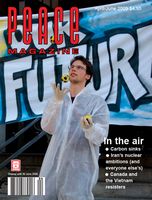
Peace Magazine Apr-Jun 2009, page 29. Some rights reserved.
Search for other articles by Rene Wadlow here
Richard Falk and David Krieger (eds) Palgrave Macmillan, 2008, 291pp.
There has always been an ebb and flow of popular interest in eliminating nuclear weapons from the world, and currently, there seems to be a rising tide of activity. Men who did little to curb nuclear weapons when they were in power are now saying that something should be done: "The only sure way to prevent nuclear proliferation, nuclear terrorism and nuclear war is to rid the world of nuclear weapons." Since peace-making depends on coalition building we cannot belittle these new-found friends.
David Krieger and Richard Falk, long-time activists for the abolition of nuclear weapons within the framework of world law, have edited a book which will be useful in the new debates and strategy making, although many of the issues have been discussed before. There have always been at least two major aspects of nuclear issues -- the one is to prevent the proliferation to new states, the other is to reduce the number of warheads among the existing nuclear-weapon states. The long chapter on Iran by Asli Bali is the most action-oriented and will be useful as policy toward Iran is debated. The reduction of the number of warheads seems to be on the table of new US-Russia negotiations.
A second theme which has colored popular action on nuclear weapons has been whether to place an emphasis on the goal of total abolition or on partial steps such as the ratification of the 1996 Comprehensive Nuclear Test Ban Treaty. Those working for partial measures have always said that abolition was the ultimate aim, but in practice, the partial measures always became the focus of action. I recall that when I was in college, I used to walk to relax and sometimes would meet Albert Einstein walking from his office to his home. I would say "Good evening, Professor Einstein," and he would reply "Good evening, young man." Although I had no idea then or now what his theories were about, I knew that they had something to do with atoms, and he had come out early for nuclear control. "One World or None" was the slogan of the late 1940s. Einstein's final appeal shortly before his death, the Russell-Einstein Manifesto (1955) with its call to think "not as members of this or that nation, continent or creed, but as human beings" is reprinted in the book.
When I used to see Einstein, I was already active on the partial measures of the time -- an end to testing nuclear weapons in the atmosphere. I had followed the lead of Senator Estes Kefauver who was the first US political leader to attack nuclear testing. As Kefauver had taken on the link between politics and organized crime, he could take on also the US Atomic Energy Commission which was deaf to all calls to prevent nuclear fallout from entering the food chain. It took till 1963 to get the tests to move below ground, but the 1950s nuclear testing campaign was the entry point of my generation to nuclear issues.
I tend still to stress limited steps within the framework of regional settlements of disputes.There seem to me to be three opportunities to press ahead, and there are ideas throughout the book which will be helpful in developing position papers.
1) The first and easiest (because it involves two states without major conflict issues) is a reduction in the number of nuclear warheads of the USA and Russia -- the number of 1000 each seems to be on the table. It is still too many and strategic thinking in the two countries is not very clear what they are for, but in this case "fewer is better," so let us push for this sharp reduction while we try to see what role the USA and Russia can usefully play in the world society.
2) The second opportunity is for a nuclear-weapon free zone in the Middle East. The elimination of Israeli nuclear weapons and no nuclear-weapon development in Iran would help reduce Middle East tensions. Mohammed ElBaradei of the IAEA has been calling for this Middle East nuclear weapon free zone for some time and has a useful chapter in the book. However, there will have to be strong popular pressure for such a zone as neither the Israeli nor the Iranian government seems to be moving fast in the direction.
3) The third opportunity for non-governmental suggestions is the 2010 review conference of the Treaty on the Non-Proliferation of Nuclear Weapons. The Review conferences every five years have been the most NGO-friendly of the arms control negotiations. I had chaired the NGOs attending the 1975 and 1980 reviews and with the help of Ambassador Garcia Robles of Mexico, the NGOs had the ability to distribute proposals and to interact fully, though not to address the conference. Our proposals were widely discussed and even presented by one government as its own. At the 1980 review when no government text could be agreed upon, the NGO draft was seriously discussed at a midnight meeting of the Conference Bureau, but wording was not the real issue. After the 1985 Review I gave up, having repeated Article VI even in my sleep. However 2010 could be the time to pull together new NGO thinking on the issues and make a real effort during the preparatory phase.
Falk and Krieger have produced a good background document to help in drafting a comprehensive set of proposals.
Reviewed by René Wadlow, Representative to the UN, Geneva, for the Association of World Citizens

Peace Magazine Apr-Jun 2009, page 29. Some rights reserved.
Search for other articles by Rene Wadlow here